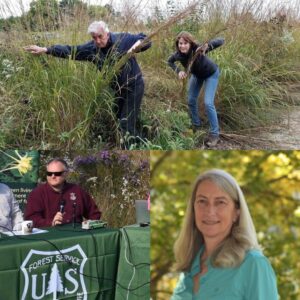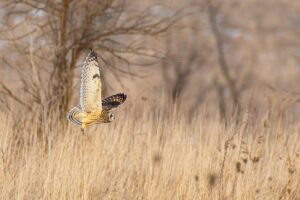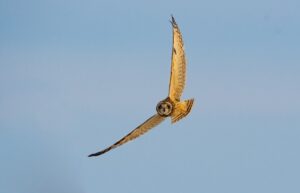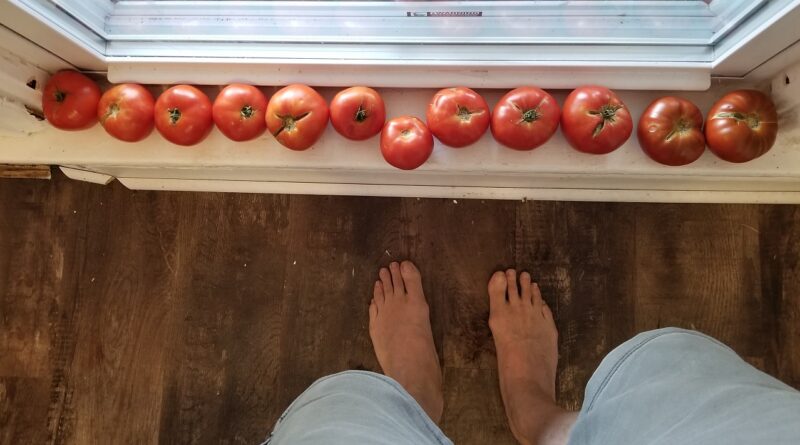Happy Not 2020! Tomatoes and Tallgrass Prairie
Podcast: Play in new window | Download (Duration: 2:01:38 — 58.1MB)
Subscribe: Apple Podcasts | Spotify | Android | iHeartRadio | Podchaser | Email | TuneIn | RSS | More
(January 3, 2021) I hate SEO and SEO hates me. In case you aren’t a slave to websites and blog posting, SEO stands for Search Engine Optimization. Whenever I write one of these blog posts, I have a list of things that I’m supposed to do to make sure that The Almighty Google (and other, lesser search engine deities) find my precious words and spread them throughout the Etherverse. I hate every one of those instructions. Nonetheless, I dutifully work as many of them into my precious prose as I possibly can. Which is where the headline Happy Not 2020 Tomatoes and Tallgrass Prairie comes in.
SEO absolutely despises the idea that a blog post could be about more than one subject. Silly me! My show often has three or four different topics. Which means that, occasionally, I mash all of the topics into one headline. SEO really hates that. But I don’t care.
In this case, Peggy and I start with salutations to all of you at the start of this new year. To coin a phrase, Happy Not 2020! I think we can all agree on that, n’est-ce pas?
Happy Not 2020! Part I: Tomatoes
But I also want folks to know that we’re welcoming Dr. Harry Klee back to the show. He last joined us about three and a half years ago, which is much too long a time between visits for a man who is attempting to breed the perfect tomato. I discovered his work more than five years ago, when I stumbled across an article in Slate with this headline: This Is the Perfect Tomato: But supermarkets refuse to sell it.
At the time, Dr. Klee had produced a tomato he named The Garden Gem because it is a prolific plant, it doesn’t bruise while being shipped, resists many tomato diseases and, best of all, it has a lovely flavor, unlike most tomatoes you will find in the grocery store. Since then, he has bred tomatoes like the Garden Treasure, Garden Ruby, “B” Hybrid and “R” Hybrid. You can find more at the Klee Lab cultivars page.
I know a little bit about these tomatoes because I have grown several of them myself for five years. My favorite is the Garden Ruby (formerly “W Hybrid), though I have a fondness for the Garden Gem, too.
In a newsletter at the end of 2020, Klee wrote,
We are excited to announce our Citizen Science Initiative is NOW LIVE! Be a part of tomato history–help determine which of our newest varieties will be the next release. When you participate in this special program, you will receive two of our newest varieties to test in your garden. We will ask you to collect data on performance and flavor relative to the most widely grown variety, Better Boy. As an added thank you for participating, we will include seeds of our improved Garden Gem with enhanced disease resistance against late blight for your eating pleasure.
To help contribute to the development and distribution of new varieties through the Citizen Science Initiative we suggest a $25 donation to participate.
If you love tomatoes, it will be the best $25 you ever spent. Dr. Harry Klee returns to the show today to talk about the new initiative. BTW, you can also find some of these tomatoes at Proven Winners.
Part II: Midewin Tallgrass Prairie
Compared to other subjects, we seem to do a lot of reporting about Midewin Tallgrass Prairie near Wilmington, Illinois. That’s probably because we’re in love with the concept of the place. Here’s what we mean. Illinois was once covered by millions of acres of prairie. Because, in the formation of this country, prairie land was among the least respected of all biomes, and because its soil was so fertile, we rapidly plowed it under and replaced it with farms.
Only now, with the hindsight of decades of science, have we learned what a tragedy that was. So, in 1995, when the site of the former Joliet Arsenal was chosen as a place where about 19,000 acres of that prairie might be restored, it was a cause for celebration. This excellent article from Landscape Architecture magazine in March of 2020 has more.
 There are 20 national grasslands in the USDA Forest Service system, but there’s only one national tallgrass prairie, Midewin National Tallgrass Prairie. Despite its name, it is not a prairie reserve, but public land managed by the forest service as part of the National Forest System, and the only one of its kind, says Karen Di-Bari, the director of the Conservation Connect program at the National Forest Foundation. More than 31 square miles—20,283 acres—make up this former World War II U.S. Army arsenal site. More than 13,000 acres are open to the public.
There are 20 national grasslands in the USDA Forest Service system, but there’s only one national tallgrass prairie, Midewin National Tallgrass Prairie. Despite its name, it is not a prairie reserve, but public land managed by the forest service as part of the National Forest System, and the only one of its kind, says Karen Di-Bari, the director of the Conservation Connect program at the National Forest Foundation. More than 31 square miles—20,283 acres—make up this former World War II U.S. Army arsenal site. More than 13,000 acres are open to the public.
As the lone federally protected tallgrass prairie in the United States, DiBari says, it is the largest piece of public land in the country that supports a tallgrass prairie and the largest public open space in the Chicago metropolitan region. “Like the largest island in an archipelago of protected areas,” she says.
Congress authorized conversion and preservation of the land by passing the Illinois Land Conservation Act of 1995, signed into law by President Bill Clinton in 1996. In installments from the army, the USDA Forest Service took over its management and began the process of restoration.
Another reason to celebrate Happy Not 2020 is the 25th year of this impressive but difficult effort, which Midewin will be celebrating all year. Here are some of the events scheduled through May.

January 5, 6pm – MIDEWIN NTP: A HAVEN FOR GRASSLAND BIRDS, AND MORE. On National Bird Day, they will focus on how a dream is being realized to increase sustainable habitat for native Illinois grassland birds and more.
February 10, 6pm – HAPPY ANNIVERSARY MIDEWIN NTP. Journalist and prairie restoration advocate Bill Kurtis will give a keynote speech in a Silver Anniversary celebration program sponsored by the National Forest Foundation. Two-time James Beard Award-winning Executive Chef Sarah Stegner of Prairie Grass Café will demonstrate wellness cooking with prairie ingredients. NFF President and CEO Mary Mitsos will be master of ceremonies. Register here.

March 3, 6pm – MIDEWIN NTP: CARING FOR THE LAND AND SERVING PEOPLE. WORLD WILDLIFE DAY A special focus on some of the USDA Forest Service subject matter experts who have made a difference over the past 25 years.
April 22, 6pm – MIDEWIN NTP: 25 YEARS OF VOLUNTEERS AND PARTNERS. EARTH DAY A close look at essential pieces in the restoration puzzle: Volunteers and Partners.
May 20, 6pm – POLLINATING AMERICA’S PRAIRIE: WE’VE ONLY JUST BEGUN LOOKING BACK AND PLANNING AHEAD FOR THE NEXT 25 YEARS. WORLD BEE DAY and AMERICAN WETLANDS MONTH A special focus on “pollinating” prairie restoration now and in the future with a look at the roles of NFF and USDA FS Youth Conservation Corps programs and more.
Of course, we would be remiss if we didn’t mention The Bison Project. In 2015, a heard of 27 bison were introduced as a 20-year experiment to determine whether their presence would have an effect on the restored prairie and, ultimately, the amount and variety of wildlife. The herd now numbers more than 80.
While cattle currently graze on parts of Midewin, as a grassland management tool, bison grazing preferences are quite different from those of cattle. Part of the experiment is to determine if bison grazing will promote forb, grass and shrub diversity that is more compatible with native tallgrass prairie. The integration of bison into Midewin’s restoration practices will also look at if the bison provide a higher quality habitat for grassland birds and other animals, when compared to prairie habitat maintained by cattle grazing.
Another part of the experiment is to provide safe public education opportunities about bison, their life history and role in prairie ecosystems.
The project is a joint venture of Midewin National Tallgrass Prairie, National Forest Foundation (NFF), The Nature Conservancy and many others, including citizen scientists and volunteers. While folks can watch the animals in person by visiting Midewin, the project features Bison Live Cam, which allows you to view the experiment from the comfort of your home.
To help walk us through the silver anniversary celebration of Midewin, we welcome Mary Mitsos, President and CEO of the NFF and Mike Redmer who recently began his new role as Restoration Team Leader/Natural Resources Supervisor at Midewin in October. Mike comes to the Forest Service following a near 20 year career with the U.S. Fish and Wildlife Service, but is no stranger to Midewin. While still in college, he was contracted to survey the Joliet Arsenal for amphibians and reptiles in 1993 and 1994. He also appeared on our show in September of 2018, when we broadcast live from outside an empty munitions bunker at Midewin.
And, in case we didn’t mention it, Happy Not 2020!



Happy 2021! (I prefer looking forward.) Thank you for the Midewin background info. Hubby and I have visited the trail and pass it often heading to Wilmington. Thanks too for the calendar of activities. And don’t forget the herd of bison!
Happy 2021 to you, too, Shirley! Thanks for reading the blog. You’re right–I left out information about the bison. That omission has now been corrected. Hope you catch the show on Sunday morning. – Mike